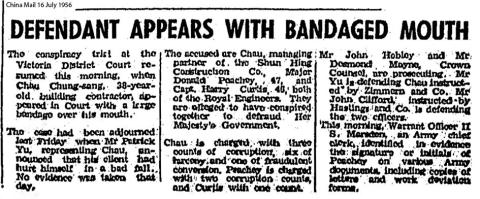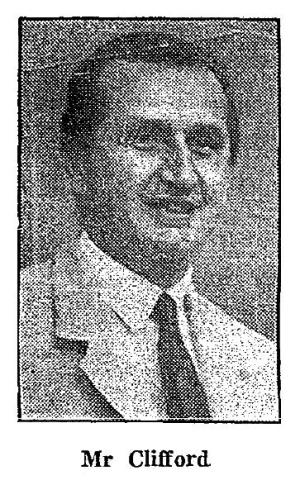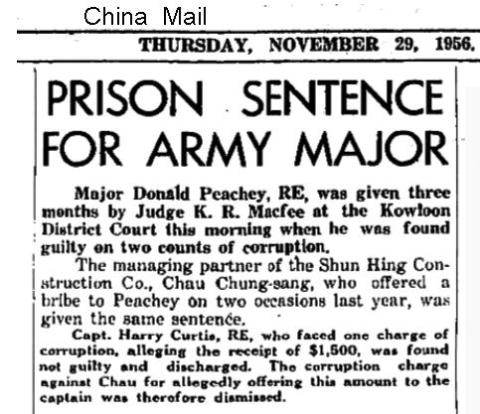Route TWISK - The Shenanigans of British Army Officers & Building Contractors During the post-war 1950s.
There are multiple gwulo entries under “Route TWISK”. In one of the longer posts containing several photos and comments (headed “Route Twisk [1953-] “ an anonymous commenter relates a story how “Route Twisk was supposed to have been paved to a certain width throughout its length but after it was completed (and the contractor paid) it was discovered to be one foot narrower than the specification! Needless to say, the contractor was no longer available to answer any questions”
Elsewhere in another gwulo post about Roadworks at the KCR Terminus ( “ren32” writes “there is a story that the cost of construction off Route TWISK was reduced secretly and somebody pocketed the proceeds” and asks is this were true. Furthermore, “IDJ“ under the heading ‘Backhanders’ writes “In the 1960s and probably well before that and even after, it was common for road-works contractors to deviate from contract specifications on trenchwork and similar works not to dig as deep as required. Thereby water & gas-pipes-electricity cables etc would be installed quite near the road surface. No doubt money or favours changed hands.”
Well now that we can readily access the SCMP digital archives through “ProQuest” and other newspaper archives, courtesy of the HK Public Libraries online website, I have tracked down the answer to ren32’s question “was this true?”
The answer is affirmative. There was a long, complex and eventful corruption trial during 1956 when two senior British Army officers and a building contractor were charged with multiple corruption offences related to construction and repairs to the surface of Route “TWSK”, (without an “I”) as it was then designated. The trial began in February 1956 when Major John Donald Peachey R.E and Captain Harry Curtis, also attached to the Royal Engineers, were both charged with receiving bribes from a contractor, Chau Chung-sang of the Shun Hing Construction Company. Chau was simultaneously charged with conspiring to pay bribes to the two Army officers. These offences were alleged to have occurred in relation to the supply of sub-standard concrete aggregate and also the use of insufficient bitumen to meet the specified standards during the period 1953-1954.
The case dragged on and off for almost the whole year with numerous military and construction company records having to be examined and then verified by a string of both police and military personnel, testifying as to the accuracy of the records and who in the military had certified them. About half way through the proceedings in July, the third defendant (the contractor Chau), was in the process of being examined in the witness box when after that day’s proceedings, he “had a nasty fall”. The trial had to be adjourned again for some days until the defendant was fit enough to reappear in court. When he did turn up, he was still heavily bandaged around his face and mouth. Whether he had suffered a “talking to” by the triads controlling the construction industry never became clear.
Then on 4th August a “bombshell exploded” when Mr Arthur John Clifford, the barrister defending both army officers was stabbed and killed in broad daylight outside the HSBC Headquarters on Des Voeux Road. Although suspicions and gossip about this killing must have raged within the community, no evidence ever came to light that the killing might have been related to the corruption case. Poor Mr Clifford just happened to be in the wrong place at the wrong time.
He was killed by an unemployed Singaporean Chinese, Quik Bah-chee who had been “hearing voices”. Quik was later certified as a schizophrenic. Quik’s later trial on a murder charge also dragged on through the Supreme Court for the remainder of that year and resulted in a hung jury, divided over whether this was manslaughter or murder. This failure to reach a verdict required a retrial and in the second trial the verdict of murder was eventually reached although with a rider “while his mind was disturbed”.
The murdered lawyer, A. J. Clifford, was a highly respected Barrister who had frequently defended the underdog for little or no fee. Born in 1910, he had been called to the Bar in UK in 1938. Following the war, during which he served with the Eighth Army in Eritrea, he came to Hong Kong in 1946 and was appointed a Crown Counsel. After two years he moved into private practice, setting up his own chambers.
Returning to the corruption trial ; because of the Clifford murder, the court proceedings did not get underway again until mid-August when Mr J.C.B. Slack, a solicitor with Messrs Hastings, appeared in court to take over the defence of the two Army officers. During this renewed hearing the District court judge, K.R. Macfee revealed his exasperation with the prolonged proceedings complaining about ever “unreliable witnesses”. The one on this particular day being a man surnamed Yuen who was engaged by the War Department as a Deputy Clerk of Works. Never answering the questions put to him under cross examination directly with a “yes” or a “no”, Yuen, according to Judge Macfee, just “gabbled away” to the point that “I have reached the end of my endurance”. It was clear from the protracted proceedings that few of the witnesses from either the prosecution or the defence side were comfortable with being in the witness box and facing deeply probing questions about how business was conducted in those days between the contractors and the War Department, whose budget for this project was a whopping £57,000, a lot of money at that time.
Eventually on 29 November 1956, the trial concluded. Major Peachey was found guilty of two charges of corruption which related to the purchase of a car from Wallace Harper & Co for Peachey, but which was paid for substantially (in excess of HK$10,000) by the Shun Hing Construction Co. Captain Curtis had faced a similar charge but was found not guilty on account of the evidence in his case not being so strong, thus affording him the benefit of the doubt. The Sun Hing contractor Chau Chung-sang was found guilty of bribing Peachey. Both Peachey and Chau were sentenced to three months imprisonment with the judge remarking “that corruption was too prevalent in Hongkong and he did not think a fine would justify the offence”.
Those were days………………….!





The Route Twisk Scandal
Thanks to all concerned for the update on the Route Twisk Scandal. The rumour seems to have been true then!!!(in Spades!)
Route TWSK
Sorry to be such a nit picker but the road was TWSK spelt without an i though pronounced with one. An acronym for Tsuen Wan - Sek Kong, the start and finishing points of the restricted military road as I am sure many readers already know!
I remember being driven by an European friend over the road in early 1960 and thinking we were being very daring because civilians in those days were not allowed to use it.
Route Twsk or Twisk
Thank you for your response. I taught at Sek Kong Primary School for 17 years from 1978- to 1998. The school was ,as you know,on Route Twsk . So I am aware of the origin of the name. However we were all in the habit of calling it Twisk and writing it like that too. Thanks.
@ nickwilson1956 : "Sorry to be such a nit picker"
If you (nickwilson1956) had read the full text of my article, I explained that the road was originally designated as "TWSK" without the "I".
to wit: " There was a long, complex and eventful corruption trial during 1956 when two senior British Army officers and a building contractor were charged with multiple corruption offences related to construction and repairs to the surface of Route “TWSK”, (without an “I”) as it was then designated. "
Route Twsk
Yes I did read your response.I have been in Hong Kong for 43 years and I am fully aware that the road is called Twsk and why.
My post only said that we called it Twisk . Why does this matter?
Sorry. I'll make sure next
Sorry. I'll make sure next time I look for nits to pick elsewhere
Nick
Sorry. I'll make sure next
Sorry. I'll make sure next time I look for nits to pick elsewhere
Nick
Ford - Road crossing on Route Twisk
Can anybody remember driving down a very steep slope on this road and passing over a ford at the bottom which was dry during the winter but usually had a few inches of water during the rainy season? (it could be quite a torrent during heavy downpours).
May be my memory is playing tricks and this was on some other road in the N.T. at that time. If I am correct about the ford during the 1960s, I guess this section of road quite soon had a bridge over this water course,
Route TWSK
I seem to remember a Bailey bridge somewhere along the wey, but cannot put a date on when I saw it. Definitely post 1960. The bridge may have replaced the ford you speak of as you suggested.
Nick
Route TWSK/TWISK
Thankyou Nick. We need more agreements to differ like this in our lives!
TWSK/TWISK
Yeaaaaaahh ! Let's TWSK again like we did last summer ........ .
.
Ooh
Yes let's!!